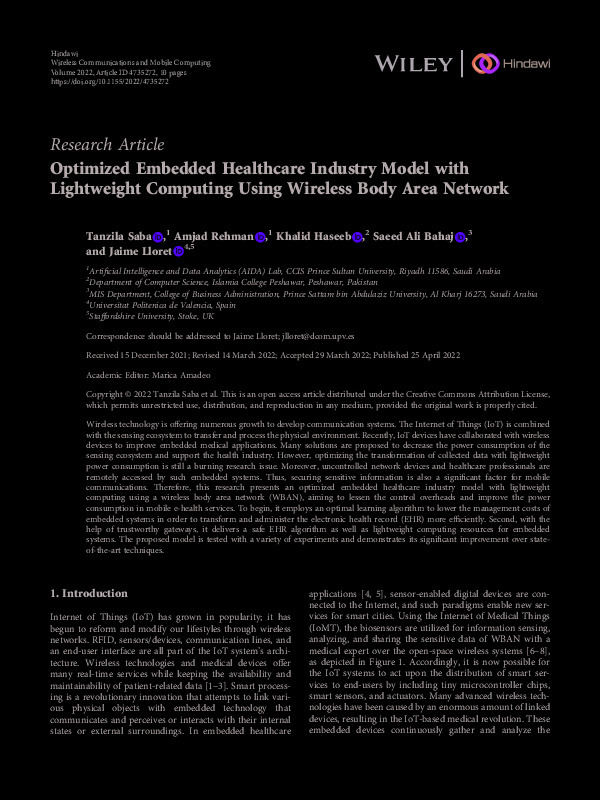JavaScript is disabled for your browser. Some features of this site may not work without it.
Buscar en RiuNet
Listar
Mi cuenta
Estadísticas
Ayuda RiuNet
Admin. UPV
Optimized Embedded Healthcare Industry Model with Lightweight Computing Using Wireless Body Area Network
Mostrar el registro sencillo del ítem
Ficheros en el ítem
| dc.contributor.author | Saba, Tanzila
|
es_ES |
| dc.contributor.author | Rehman, Amjad
|
es_ES |
| dc.contributor.author | Haseeb, Khalid
|
es_ES |
| dc.contributor.author | Bahaj, Saeed Ali
|
es_ES |
| dc.contributor.author | Lloret, Jaime
|
es_ES |
| dc.date.accessioned | 2024-01-23T19:01:10Z | |
| dc.date.available | 2024-01-23T19:01:10Z | |
| dc.date.issued | 2022-04-25 | es_ES |
| dc.identifier.issn | 1530-8669 | es_ES |
| dc.identifier.uri | http://hdl.handle.net/10251/202086 | |
| dc.description.abstract | [EN] Wireless technology is offering numerous growth to develop communication systems. The Internet of Things (IoT) is combined with the sensing ecosystem to transfer and process the physical environment. Recently, IoT devices have collaborated with wireless devices to improve embedded medical applications. Many solutions are proposed to decrease the power consumption of the sensing ecosystem and support the health industry. However, optimizing the transformation of collected data with lightweight power consumption is still a burning research issue. Moreover, uncontrolled network devices and healthcare professionals are remotely accessed by such embedded systems. Thus, securing sensitive information is also a significant factor for mobile communications. Therefore, this research presents an optimized embedded healthcare industry model with lightweight computing using a wireless body area network (WBAN), aiming to lessen the control overheads and improve the power consumption in mobile e-health services. To begin, it employs an optimal learning algorithm to lower the management costs of embedded systems in order to transform and administer the electronic health record (EHR) more efficiently. Second, with the help of trustworthy gateways, it delivers a safe EHR algorithm as well as lightweight computing resources for embedded systems. The proposed model is tested with a variety of experiments and demonstrates its significant improvement over state-of-the-art techniques. | es_ES |
| dc.language | Inglés | es_ES |
| dc.publisher | John Wiley & Sons | es_ES |
| dc.relation.ispartof | Wireless Communications and Mobile Computing | es_ES |
| dc.rights | Reconocimiento (by) | es_ES |
| dc.subject | Architecture | es_ES |
| dc.subject | Internet | es_ES |
| dc.subject | Things | es_ES |
| dc.subject | Wireless body area network (WBAN) | es_ES |
| dc.subject.classification | INGENIERÍA TELEMÁTICA | es_ES |
| dc.title | Optimized Embedded Healthcare Industry Model with Lightweight Computing Using Wireless Body Area Network | es_ES |
| dc.type | Artículo | es_ES |
| dc.identifier.doi | 10.1155/2022/4735272 | es_ES |
| dc.rights.accessRights | Abierto | es_ES |
| dc.contributor.affiliation | Universitat Politècnica de València. Escuela Politécnica Superior de Gandia - Escola Politècnica Superior de Gandia | es_ES |
| dc.description.bibliographicCitation | Saba, T.; Rehman, A.; Haseeb, K.; Bahaj, SA.; Lloret, J. (2022). Optimized Embedded Healthcare Industry Model with Lightweight Computing Using Wireless Body Area Network. Wireless Communications and Mobile Computing. 2022:1-10. https://doi.org/10.1155/2022/4735272 | es_ES |
| dc.description.accrualMethod | S | es_ES |
| dc.relation.publisherversion | https://doi.org/10.1155/2022/4735272 | es_ES |
| dc.description.upvformatpinicio | 1 | es_ES |
| dc.description.upvformatpfin | 10 | es_ES |
| dc.type.version | info:eu-repo/semantics/publishedVersion | es_ES |
| dc.description.volume | 2022 | es_ES |
| dc.relation.pasarela | S\506770 | es_ES |








